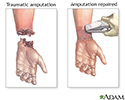Amputation - traumatic
Loss of a body part
Traumatic amputation is the loss of a body part, usually a finger, toe, arm, or leg, that occurs as the result of an accident or injury.
Considerations
If an accident or trauma results in complete amputation (the body part is totally severed), the part sometimes can be reattached, often when proper care is taken of the severed part and stump.
In a partial amputation, some soft-tissue connection remains. Depending on how severe the injury is, the partially severed extremity may or may not be able to be reattached.
Complications can occur when a body part is amputated. The most important of these are bleeding , shock , and infection.
Bleeding
Bleeding is the loss of blood. Bleeding may be:Inside the body (internally) Outside the body (externally)Bleeding may occur:Inside the body when blo...

Shock
Shock is a life-threatening condition that occurs when the body is not getting enough blood flow. Lack of blood flow means that the cells and organs...

Long-term outcome for an amputee depends on early emergency and critical care management. A well-fitting and functional prosthesis can speed rehabilitation.
Causes
Traumatic amputations usually result from factory, farm, power tool accidents, or from motor vehicle accidents. Natural disasters, war, and terrorist attacks can also cause traumatic amputations.
Symptoms
Symptoms may include:
- Bleeding (may be minimal or severe, depending on the location and nature of the injury)
- Pain (the degree of pain is not always related to the severity of the injury or the amount of bleeding)
- Crushed body tissue (badly mangled, but still partially attached by muscle, bone, tendon, or skin)
First Aid
-
Check the person's airway (open if necessary); check breathing and circulation. If necessary, begin rescue breathing, cardiopulmonary resuscitation (
CPR
), or
bleeding control
.
CPR
CPR stands for cardiopulmonary resuscitation. It is an emergency lifesaving procedure that is done when someone's breathing or heartbeat has stopped...
Read Article Now Book Mark ArticleBleeding control
Bleeding is the loss of blood. Bleeding may be:Inside the body (internally) Outside the body (externally)Bleeding may occur:Inside the body when blo...
 ImageRead Article Now Book Mark Article
ImageRead Article Now Book Mark Article - Try to calm and reassure the person as much as possible. Amputation is painful and very frightening.
- Control bleeding by applying direct pressure to the wound. Raise the injured area. If bleeding continues, recheck the source of the bleeding and reapply direct pressure, with help from someone who is not tired. If the person has life-threatening bleeding, a tight bandage or tourniquet will be easier to use than direct pressure on the wound. However, using a tight bandage for a long time may do more harm than good.
- Save any severed body parts and make sure they stay with the person. If possible, remove any dirty material that can contaminate the wound, then gently rinse the body part if the cut end is dirty.
- Wrap the severed part in a clean, damp cloth, place it in a sealed plastic bag and place the bag in an ice water bath.
- DO NOT put the body part directly in water without using a plastic bag.
- DO NOT put the severed part directly on ice. DO NOT use dry ice as this will cause frostbite and injury to the part.
- If cold water is not available, keep the part away from heat as much as possible. Save it for the medical team, or take it to the hospital. Cooling the severed part allows reattachment to be done at a later time. Without cooling, the severed part is only good for reattachment for about 4 to 6 hours.
- Keep the person warm.
- Take steps to prevent shock. Lay the person flat, raise the feet about 12 inches (30 centimeters), and cover the person with a coat or blanket. DO NOT place the person in this position if a head, neck, back, or leg injury is suspected or if it makes the victim uncomfortable.
-
Once the bleeding is under control, check the person for other signs of injury that require emergency treatment. Treat
fractures
, additional cuts, and other injuries appropriately.
Fractures
If more pressure is put on a bone than it can stand, it will split or break. A break of any size is called a fracture. If the broken bone punctures...
 ImageRead Article Now Book Mark Article
ImageRead Article Now Book Mark Article - Stay with the person until medical help arrives.
Do Not
- DO NOT forget that saving the person's life is more important than saving a body part.
- DO NOT overlook other, less obvious, injuries.
- DO NOT attempt to push any part back into place.
- DO NOT decide that a body part is too small to save.
- DO NOT place a tourniquet, unless the bleeding is life threatening, as the entire limb may be harmed.
- DO NOT raise false hopes of reattachment.
When to Contact a Medical Professional
If someone severs a limb, finger, toe, or other body part, you should call right away for emergency medical help.
Prevention
Use safety equipment when using factory, farm, or power tools. Wear seat belts when driving a motor vehicle. Always use good judgment and observe appropriate safety precautions.
References
American Academy of Orthopaedic Surgeons. Fingertip injuries and amputations. Updated July 2016. Orthoinfo.aaos.org. orthoinfo.aaos.org/topic.cfm?topic=A00014 . Accessed October 24, 2016.
Gross KR, Collier BR, Riordan WP Jr, Morris JA, Jr. Wilderness trauma and surgical emergencies. In: Auerbach PS, ed. Wilderness Medicine . 6th ed. Philadelphia, PA: Elsevier Mosby; 2012:chap 21.
Moore D. Management of amputations. In: Roberts JR, ed. Roberts and Hedges' Clinical Procedures in Emergency Medicine . 6th ed. Philadelphia, PA: Elsevier Saunders; 2014:chap 47.
Review Date: 9/22/2016
Reviewed By: C. Benjamin Ma, MD, Professor, Chief, Sports Medicine and Shoulder Service, UCSF Department of Orthopaedic Surgery, San Francisco, CA. Also reviewed by David Zieve, MD, MHA, Isla Ogilvie, PhD, and the A.D.A.M. Editorial team.

